
Farnell element14, as part of the Premier Farnell group, works with organisations of all sizes, from leading semiconductor manufacturers to small startups, to help them bring their products to market.
Our experience ranges from the development of custom embedded platforms, single board computers and system-on-modules to the customisation of leading single board computers such as the Raspberry Pi and BeagleBone Black to reduce time to market for our customers.
In order to ensure the highest quality and minimise the risks associated with new product development, our team of more than 130 engineers based in the USA and China employ stringent design and manufacturing processes, developed over hundreds of projects and years of experience – ensuring we get things right first time.
Getting it right, from the start
In order to help you design best practice in from the very start, we’ve pulled together some of the most helpful and interesting hints and tips from leading electronic component manufacturers to get you started. Whether you are using boards, semiconductors, passives, connectors, relays, sensors or LEDs, we’re hoping that you will find inspiration for your next project, or ideas for improving your testing and debugging.
Whatever your next project, whether you are an educator, hobbyist, professional engineer, purchaser or maintenance professional, we’ve got the products you need, available quickly and easily.
Development boards
Extend CodeBug I/O options
CodeBug (Figure 1) offers a range of inputs and outputs through Blockly programs. In addition to the six legs, there are also four expansion pins at the bottom that can be enabled as I/O. Take care as these four pins are not protected by a current limiting resistor.
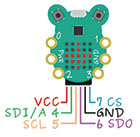
Connect a Raspberry Pi to a VGA monitor
Want to use the Raspberry Pi with an old VGA monitor? Good news: the HDMI output can be used with a cheap passive HDMI to VGA cable, provided you tweak a few values in the /boot/config.txt file. Edit the file to include the lines shown in Figure 2, and adjust hdmi_mode to match your monitor’s resolution.

Add a touchscreen to BeagleBone
Adding a touchscreen to the BeagleBone is easy using the CT43 display cape from element14. It provides a 4,3 inch 480 x 272 screen with LED backlight and capacitive touch, and a board ID EEPROM enables plug-and-play functionality with the Debian operating system.
Cellular communication made easy
For applications or prototypes that need long-range cellular communications, interfacing to a mobile phone is an easy solution. Motorola’s Moto Mods development kit is the fastest way to produce a complete system, using a board that snaps inside the Moto Z phone using strong magnets. Personality cards demonstrate how to use sensors, integrate audio or add a display, and the HAT adaptor lets you plug Raspberry Pi HATs into the MDK.
Semiconductors
Using USB in industrial applications
One of the benefits of USB is the ability to power a remote device through the USB port. Unlike consumer applications, where devices share a common ground, industrial equipment is often powered from different building ground references, resulting in the USB cable creating a ground loop, which introduces noise that can corrupt data transmission or even damage equipment.
This problem can be eliminated by breaking that ground loop with a USB isolator, such as the Analog Devices ADuM3160 or ADuM4160. Both devices will galvanically isolate the USB devices while seamlessly allowing communication between the two systems, ensuring reliable operation in an industrial environment.
Steps to good boost converter PCB layout
In power conversion designs, PCB layout is critical. Placing and routing components in the following order is an optimised approach that will ensure good results:
1. Output capacitor: ensure it is close to the IC to reduce parasitic inductance.
2. Inductor and snubber: as close to the IC as possible to reduce radiated EMI.
3. Input capacitor and Vin pin: less critical than the output components.
4. Small signal components: passive components for the analog and logic functions
5. Signal ground and polygon plane: ensure no large currents are flowing in the signal ground.
Expanding key switch inputs on microcontrollers
The number of available microcontroller input ports that can be used for key switches can be limited, presenting challenges in some applications. An alternative approach is to use an analog input, which can support multiple keys, for example the 4-key application shown in Figure 3.
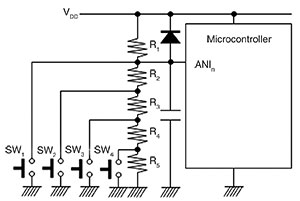
Secure cloud for IoT applications
The AWS Zero Touch Secure Provisioning Platform offers the industry’s first end-to-end security solution for Internet of Things (IoT) devices that connect to the Amazon Web Services (AWS) cloud, helping IoT devices to comply quickly and easily with AWS’s mutual authentication IoT security model.
The Microchip AWS-ECC508 provides a secure authentication method and simplifies management of the private keys in a large-scale production environment. It complies with AWS IoT just-in-time registration, offering mutual authentication between devices and the remote server. With a simple I2C connection to the host microcontroller, it provides a flexible and cost-effective solution for security and authentication in IoT applications.
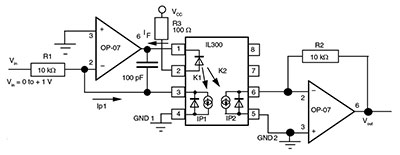
Simple low-power WANs with LoRa
The STM32 Nucleo pack, FSK/OOK RF transceiver modem and LoRaWAN software expansion package for STM32Cube provide a complete solution for low-power, wide-area network (LPWAN) connectivity for IoT and M2M end-node devices. LoRa is:
• Long range: >15 km.
• Low-power: 5-10 year expected battery lifetime.
• Low-cost: from end-node sensor cost to upfront infrastructure investment.
• Secure: with embedded end-to-end AES-128 encryption of data.
• Geolocation: enables indoor/outdoor tracking without GPS.
Better protection with eFuses
Semiconductor eFuses are alternatives to old-style one-shot fuses and positive temperature coefficient (PTC) resettable fuses. They have several advantages:
• Rapid (typically less than 10 µs) response.
• Minimal parameter shift with temperature.
• No degradation or change of on resistance after a fault.
• Programmable current limit.
• Enable and fault pins for control logic.
• Soft-start and voltage clamp to limit inrush current spikes.
• Choice of latch-off or auto-retry.
• Reverse current blocking.
Optoelectronic isolation in power supplies
To ensure high efficiency and better regulation, power supplies need a feedback loop from the output voltage. When isolation is required, particularly in AC-DC supplies that must withstand 375 V a.c. to meet international standards, optoelectronic feedback (Figure 4) provides an ideal solution.
Overcoming disadvantages of capacitive touch
Standard capacitive touch systems normally do not work through metal coverings, require special software for electrically noisy environments, and are unreliable in the presence of water or other contaminants. Microchip’s mTouch metal over capacitive technology (Figure 5) overcomes all of these limitations without compromising power consumption or design simplicity.

Passive and electromechanical
Relay coil suppression techniques
When an electromechanical relay is de-energised rapidly by a mechanical switch or semiconductor, a substantial voltage transient, which can be 1000 to 1500 V in a 12 V relay, is produced. This creates EMI, semiconductor breakdown and switch wear problems, which is best prevented by using the following suppression techniques:
• A bilateral transient suppression diode.
• A reverse-biased rectifier diode with a Zener diode in series.
• A metal-oxide varistor (MOV).
• A reverse-biased rectifier diode with a series resistor.
• A resistor, or reverse-biased rectifier diode, where conditions permit tracking without GPS.
Tool-less connectors save time
The need for ever more connections in modern systems can significantly increase commissioning time and cost. The Harting Han ES Press is an example of a new approach, where conductors can be hand-inserted, reducing effort and eliminating the need for specialist tools.
Best capacitors for decoupling
All capacitors have some equivalent series resistance and inductance (ESR and ESL). These parasitic elements can cause power droop and high-frequency noise in digital systems. Choosing the appropriate device (Table 1) can significantly decrease ESL, improving performance.
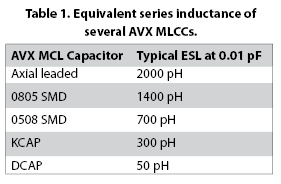
Rugged connections
From industrial and process control to portable systems used in harsh environments, equipment needs to be ruggedised. Connectors often present a challenge, with designers resorting to specialist components to ensure robustness and reliability.
Farnell’s wide range of connector suppliers includes devices for the most challenging applications, as well as ruggedised versions of familiar everyday connectors. The Amphenol D-sub family, for example, are replacements for commercial connectors with industrial variants that are waterproof to IP67, as well as Mil-DTL-24308 approved and QPL listed connectors for defence applications.
Opto, LED lighting and sensors
Matrix connection improves LED reliability
Connecting LEDs in strings is an established approach for lighting applications, but ageing LEDs can fail, breaking the circuit. A better approach is to connect LEDs in a matrix (Figure 6), where a failure does not stop the others working: the only impact is a slightly higher current in the parallel LEDs.
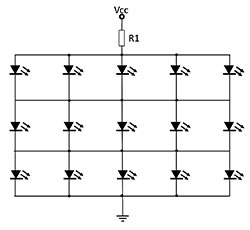
SMPS topologies for LED lighting
There are a number of different SMPS topologies (Table 2), all of which have different benefits for LED lighting applications.
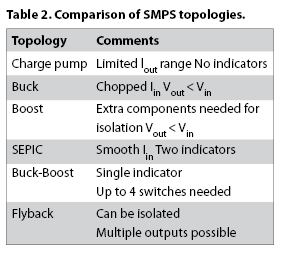
Improving accelerometer accuracy
There are two types of noise in accelerometers: electronic noise and mechanical noise from the MEMS cell. The signal to noise ratio is often greater than the quantisation error, resulting in a reduction of the effective number of bits.
Oversampling and decimation is an established way of improving the signal to noise ratio, with an oversampling factor of 4, improving SNR by 6 dB: effectively an extra bit of resolution. A factor of 64 adds 3 bits due to an SNR improvement of 18 dB. Designers can therefore trade off accuracy against speed and power consumption by using oversampling techniques.
IR eyes save energy
Panasonic Grid-EYE sensors are ideal for energy-saving or comfort applications that need to detect the presence of people or temperature distribution in an 8 x 8 grid. The MEMS sensor can detect sudden changes with a 10 images/second capability.
Test and measurement
Debugging serial busses with oscilloscopes
The increasing use of serial busses to save board space, pin count, cost and power in embedded systems means that new debugging approaches are required. Conventional oscilloscopes and logic analysers can trigger on the start of a message, but their state and pattern triggers are impractical for identifying specific message content.
The optional serial triggering and analysis capability of Tektronix oscilloscopes make them a powerful tool for embedded system designers, removing the need for edge triggering by using common busses’ conditions or data instead. The scopes also display the data and address in clear hex or binary, further speeding up debugging.
Choosing the right probes
Sometimes it can be very difficult to make contact with the exact point that you need during testing: using probes with high-density, multi-layer circuit boards and closely spaced components is difficult and can cause damage.
• Single point probes are the most common, but are typically too large for modern circuit boards.
• Sharp probe tips get at small contact points, and are usually not plated to allow re-sharpening.
• Hooks and pincers and IC clips allow connections to be left in place.
In addition to the importance of safety insulation, don’t forget the importance of leads: dissimilar metals can act like thermocouples and affect voltage measurements in the micro volt range.
Thermal inspection finds problems fast
When investigating issues in electronic and electrical systems, a thermal camera is a valuable tool to quickly identify hot-spots and troubleshoot problems in components from breakers and fuses to connections and semiconductors on boards.
Safer multimeter measurements
Multimeters often fail because they have been subjected to transients caused by motors, power conversion equipment or lightning strikes. The voltage rating will not tell you how well that meter was designed to survive high transient impulses, so make sure you choose meters rated for the appropriate over-voltage category.
For more information contact Farnell element14, 0800 111 057, info- [email protected], http://export.farnell.com/welcome-south-africa
© Technews Publishing (Pty) Ltd | All Rights Reserved